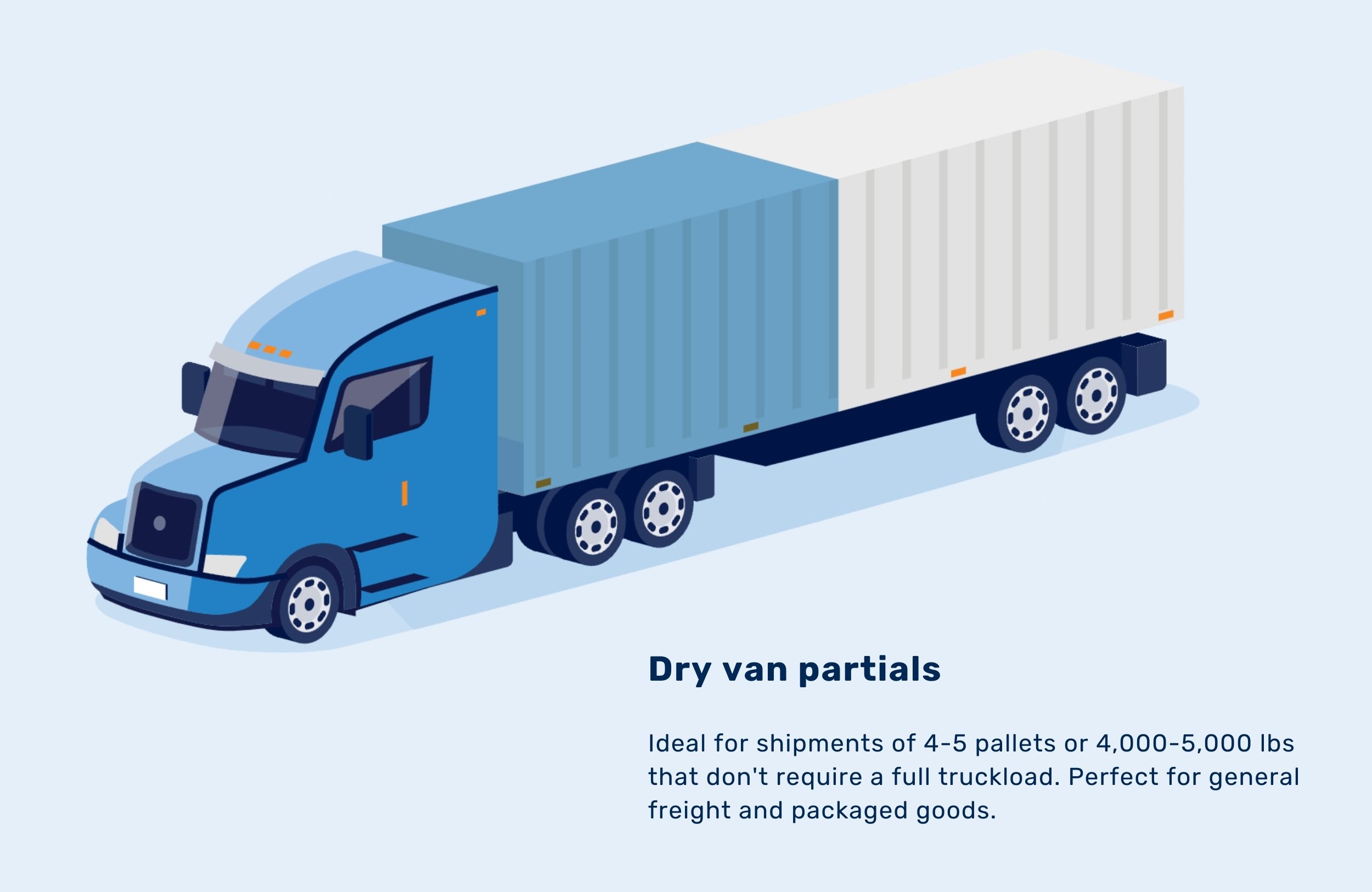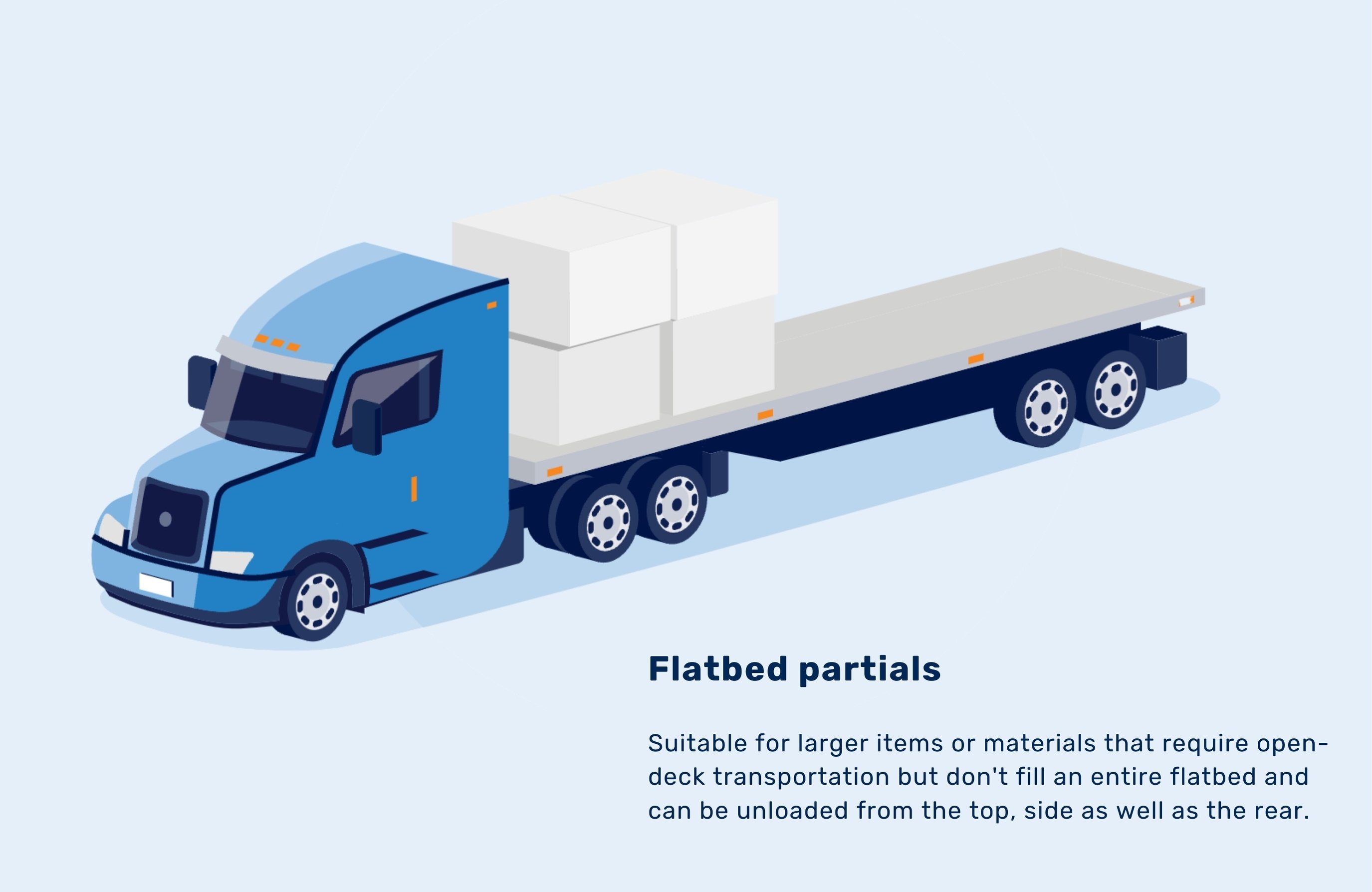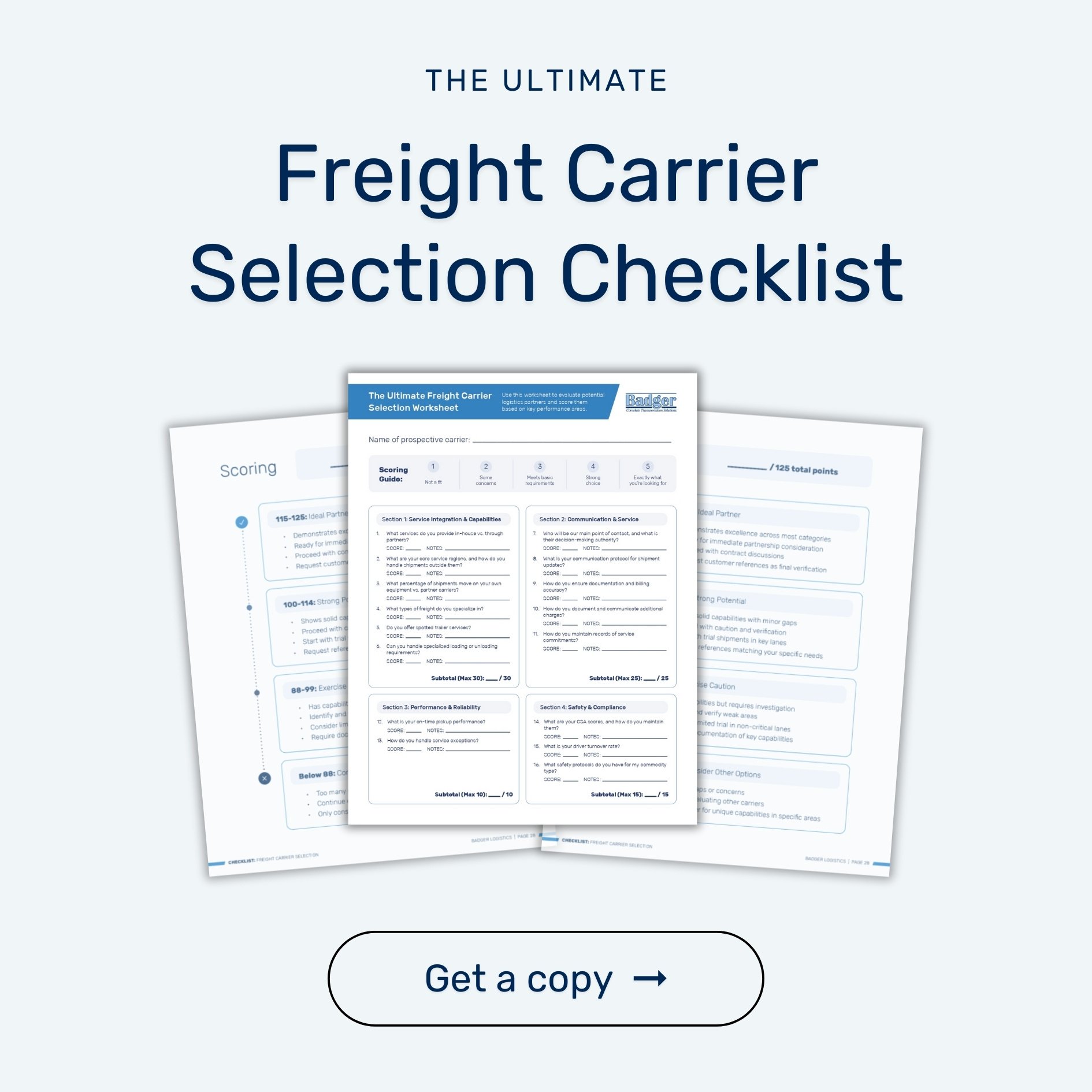Key takeaways
- Partial truckload (PTL) shipping occupies the sweet spot between LTL and FTL for shipments typically in the 5-25 pallet range or 4,000-30,000 pounds, offering better pricing than full truckload and less handling than traditional LTL.
- PTL shipments travel on the same truck from origin to destination without being transferred between terminals, resulting in less handling, reduced damage risk, and faster transit times compared to traditional LTL.
- The ideal PTL candidate ships 4-5 pallets or more (4,000-5,000+ pounds) that doesn't require a full trailer, benefits from reduced handling, and has some flexibility on delivery timing.
- PTL is available for dry van, flatbed, and intermodal shipments, but is harder to find for refrigerated freight due to temperature control and liability concerns.
- PTL pricing is influenced by freight dimensions, weight, distance, market conditions, and specialized needs, typically offering savings over FTL when shipping less than 65-70% of a full trailer.
- When selecting a PTL provider, look for carriers with strong networks in your shipping lanes, experience with your freight type, and the ability to provide proper handling, tracking, and damage prevention.
Badger Logistics delivers expert partial shipping services for reliable and efficient transportation of your mid-sized freight. Learn more about our partial freight services and get a competitive rate quote to join hundreds of shippers discovering a better alternative to traditional LTL.
A brief introduction
If you're shipping more than a few pallets but not enough to fill an entire truck, you're in what I call the "partial truckload sweet spot."
You're caught between the world of less-than-truckload (LTL) with its multiple stops and extra handling and full truckload (FTL), where you're paying for space you don't need. This is exactly where partial truckload (PTL) shipping comes in, and it's a solution that can save you money, reduce damage, and simplify your logistics.
I've helped countless shippers find the right balance between service and cost with partial truckload solutions. Over the years, I've seen how partial shipments can be a game-changer for companies that understand when and how to use them effectively.
In this guide, I'll walk you through everything you need to know about partial truckload shipping — from what qualifies as a partial to when you should choose it over LTL or FTL, what equipment types are available, and how to get the best service and rates.
What is partial truckload (PTL) shipping?
Partial truckload shipping exists in that middle ground between LTL (less-than-truckload) and FTL (full truckload). It's for shipments that are too large for efficient LTL service but don't require a full 53' trailer. While traditional LTL carriers specialize in smaller shipments and can make a profit on loads as small as $10-15, partial shipments require a different operational approach.
In the brokerage world, we clearly distinguish between partial shipments and traditional LTL. LTL carriers have the hub-and-spoke system completely locked down — they're incredibly efficient at moving small shipments through their terminal networks. But once you get to a certain size, those networks become less efficient for your freight.
|
The key difference is in the handling. With true LTL service, your freight typically goes through multiple terminals — it's picked up, brought to an origin terminal, transferred to a line-haul truck, delivered to a destination terminal, and finally delivered to the end customer. That's a lot of touchpoints and opportunities for damage. Partial shipments, on the other hand, are typically loaded once and delivered once. They ride on the same truck from pickup to delivery, similar to full truckload service, but you share the trailer with other compatible shipments. This means fewer handling points, less damage risk, and often faster transit times than LTL. |
Dry vans and flatbeds are by far the most common trailer types used for partial shipments.


Size and weight: what qualifies as a partial load?
While there's no rigid industry standard for what constitutes a partial load, I generally tell customers that shipments in these ranges are prime candidates:
|
The sweet spot for partial shipping starts at about 4-5 pallets or 4,000-5,000 pounds. That's where you start seeing real advantages over traditional LTL in terms of handling and potentially cost. The upper limit depends on distance and market conditions, but once you're using more than 65-70% of a trailer, full truckload rates often become competitive."
Remember that these are guidelines, not strict rules. I've moved smaller partial shipments when the circumstances made sense, especially in soft freight markets or when the freight characteristics required special handling.
PTL vs. LTL vs. FTL: the key differences
To understand when partial truckload makes the most sense, it helps to compare it directly with the alternatives:
Traditional LTL (Less Than Truckload):
|
Partial Truckload (PTL)
|
Full Truckload (FTL)
|
The difference between partial and traditional LTL comes down to handling. In the LTL hub-and-spoke system, your freight is being touched multiple times, transferred between trucks, and often stored overnight at terminals. With partial, it's loaded once and stays on the same truck until delivery, just like truckload service.
When to choose partial truckload shipping
Partial truckload shipping isn't always the right choice, but for many situations, it can offer the perfect balance of cost savings and service quality.
Here are the scenarios where I most often recommend partial shipping to my shippers:
1. When your shipment falls in the "sweet spot"The most obvious use case is when your shipment size falls in that middle ground — too big for efficient LTL but not large enough to justify a full truck. If you're shipping 5-15 pallets that take up 12-30 feet of trailer space, partial is almost always worth considering. |
2. When you have damage-sensitive freightHigh damage rates in traditional LTL is one of the biggest reasons customers come to us looking for partial options. If you've experienced issues with product damage through standard LTL networks, partial shipments can dramatically reduce those concerns by eliminating multiple handling points. This is particularly valuable for:
|
3. When transit time and predictability matter a lotBecause partial shipments typically move directly from origin to destination without terminal delays, they often deliver faster than traditional LTL. If you need more predictable transit times — maybe for just-in-time inventory management or customer commitments — partial can offer a good middle ground between the variable timing of LTL and the premium cost of dedicated truckload. |
4. When you need special handling but not a full truckSome freight requires specific handling or equipment that's hard to get with standard LTL service. Perhaps you need flatbed service for odd-shaped items, need items to remain upright, or have specific loading requirements. Partial truckload often provides more flexibility for these special needs without the cost of a dedicated truck. |
5. When LTL would exceed classification weight limits.LTL carriers have maximum weight limits per pallet based on their freight classification system. If your individual pallets exceed these limits, you might face excessive overweight charges or refusal of service. Partial shipments typically have more flexible weight allowances and can accommodate heavier individual pieces. |
Equipment types available for partial shipments
One common misconception about partial truckload is that it's only available for dry van shipments. In reality, partial services are available across multiple equipment types, though availability varies by region and freight characteristics.
Dry van partials
The most common form of partial shipment uses standard 53' dry van trailers. These enclosed trailers protect freight from the elements and offer security similar to full truckload service. In my experience, dry van partials are widely available in most markets and most shipping lanes, especially for distances over 500 miles.

For standard boxed or palletized items that don't need temperature control, dry van partial is usually the most accessible and cost-effective option. It works well for everything from manufacturing components to retail goods to packaged industrial products.
Flatbed partials
Partial shipments are available for flatbed freight as well. This is particularly useful for items that are too large, oddly shaped, or need to be loaded from the top or sides. Common examples include construction materials, machinery, metal products, and building supplies.

Flatbed partials can be a bit more challenging to arrange than dry van, especially for shorter distances. But for the right freight, they can offer significant savings over full flatbed service while still providing the open-deck access you need.
Flatbed partial is available in various configurations:
- Standard flatbed
- Step deck (for taller items)
- Specialized equipment (more limited availability)
Intermodal partials
Intermodal transportation — using rail for the long-haul portion of the journey — is also available for partial shipments. Containers can be partially filled, making this an economical option for longer distances where transit time flexibility exists.
Intermodal partial can offer substantial cost savings for longer hauls, especially in major corridors with good rail service. It's worth considering for shipments over 750 miles where you have some flexibility in delivery timing.
Refrigerated (reefer) partial: limited availability
While refrigerated partial service does exist, it's much more limited than dry van or flatbed options. The challenges with temperature-controlled partial shipments include:
- Temperature compatibility between different products
- Liability concerns with food and pharmaceutical products
- Limited carrier availability for this specialized service
- Proper airflow requirements around products
I generally don't recommend refrigerated partial for most customers. The complexity and limited carrier base usually make dedicated reefer service the better option for temperature-controlled freight, even if it means paying for some unused space.
How partial truckload pricing works
Understanding how partial truckload is priced helps you determine when it makes financial sense compared to the alternatives. Unlike LTL, which uses complex class-based rating systems, partial pricing is more straightforward – but it still involves several factors.
Here’s a breakdown of the key factors that go into a PTL rate:
1. Space utilization
The primary pricing factor for partial shipments is how much trailer space your freight occupies. This is typically measured in either:
- Linear feet (the length of trailer space used)
- Pallet positions (how many standard pallet spots you need)
- Cubic feet (for irregularly shaped items)
The relationship between space and cost isn't perfectly linear. While you'll pay more for 20 feet than 10 feet, you won't necessarily pay twice as much. There's a scaling factor that often makes partial more economical as your shipment size increases — up to the point where full truckload becomes competitive.
2. Weight
Weight matters in partial pricing for two reasons:
- Heavy shipments may reach legal weight limits before filling the space
- Weight affects fuel consumption and equipment requirements
For most partial shipments, space is the limiting factor rather than weight. However, dense products like metal, machinery parts, or liquids may hit weight constraints first.
3. Distance and lane
Just like any freight mode, the distance between origin and destination significantly impacts price. Longer hauls generally mean higher rates, though the cost per mile typically decreases as distance increases.
Lane factors also matter. Shipping between major markets with high freight volumes usually costs less than shipping to or from more remote locations where carrier options are limited.
4. Market conditions
Freight rates fluctuate based on market conditions, and partial is no exception. Seasonality, fuel prices, capacity constraints, and general economic conditions all impact what you'll pay.
One thing I've noticed over the years is that partial shipment rates can sometimes be less volatile than full truckload rates during capacity crunches. When trucks are scarce, having the flexibility to combine shipments can actually work in your favor.
5. Special requirements
Any special needs or handling requirements will impact your partial rates:
- Liftgate service
- Inside delivery
- Limited access locations
- Appointment requirements
- Special securement needs
So, when does partial truckload make sense?
The financial break-even point between LTL, partial, and full truckload varies by market and shipment characteristics, but I generally find:
|
I always recommend running comparisons for your specific shipment parameters. The break-even points shift based on current market rates, lane dynamics, and freight characteristics. What made sense last quarter might not be the best option today.
A few PTL best practices to keep in mind
Getting the most from partial truckload shipping requires understanding some key best practices. Here's what I tell my customers to ensure successful partial shipments:
1. Provide your carrier or brokerage with accurate dimensions and weight
Accuracy is critical for partial shipments. Since your freight will be combined with other shipments, the carrier needs precise measurements to plan loading effectively. One of the fastest ways to create problems with a partial shipment is to understate dimensions or weight. If your freight takes up more space than declared, it can throw off the entire load plan and potentially lead to delays or additional charges.
|
Be sure to include:
|
2. Be flexible with your pickup and delivery times
Partial shipments require coordination between multiple pickups and deliveries. Having some flexibility in your scheduling makes it easier for carriers to combine your freight with other shipments efficiently.
When you're rigid about your pickup or delivery times, you narrow the pool of partial opportunities. Even a half-day window can dramatically increase your options and potentially lower your costs.
3. Understand transit expectations
Partial shipments typically move faster than LTL but may take slightly longer than dedicated truckload service. Understanding realistic transit times helps set proper expectations with internal stakeholders and customers.
| For most partial shipments, I advise adding 1-2 business days to standard truckload transit times as a safe estimate. This allows for the coordination involved in combining multiple shipments. |
4. Package and prepare your freight properly
Since your partial shipment will share trailer space with other freight, proper packaging is essential. Your items should be well-protected and configured to travel safely alongside other shipments.
Best practices include:
- Sturdy, well-wrapped pallets
- Appropriate banding or stretch wrap
- Clear markings and labels
- Proper weight distribution on pallets
- Protection for fragile components or edges
5. Consider opportunities to consolidate your load
If you regularly ship multiple smaller orders to the same region, consolidating them into a single partial shipment can yield significant savings over multiple LTL shipments.
One of the most effective strategies I see is customers batching their shipments to create more efficient partial loads. Instead of sending three 2-pallet shipments over a week, combining them into one 6-pallet partial shipment often reduces both cost and damage risk.
Is partial truckload right for your shipping needs? A quick checklist
After reviewing all aspects of partial truckload shipping, the question becomes: is it the right fit for your specific situation?
Here's a simple assessment to help you decide.
|
Partial truckload might be ideal for your shipping needs if:
|
|
However, other options might be better if:
|
A few partial truckload FAQs
How does partial truckload differ from LTL consolidation services?
While both involve combining multiple shipments, traditional LTL consolidation typically involves the terminal-based hub-and-spoke system with multiple handling points. Partial truckload generally provides direct service from origin to destination without terminal transfers, resulting in less handling and usually faster transit times.
Does partial truckload have the same delivery guarantees as LTL or FTL?
Partial typically doesn't offer the same guaranteed delivery programs as premium LTL or dedicated truckload service. However, transit times are generally more predictable than standard LTL due to fewer handling points and more direct routing. If you need absolute guarantees, we can discuss expedited or dedicated options.
How far in advance should I book partial truckload shipments?
For standard partial shipments, I recommend booking 2-3 business days in advance. For specialized equipment, challenging lanes, or peak shipping seasons, 3-5 business days provides the best options. With established shipping patterns, we can often accommodate shorter notice, but advance planning always yields the best results.
Will my partial shipment be on the same truck the entire journey?
Yes, that's one of the key advantages of true partial service versus LTL. Your freight stays on the same truck from pickup to delivery, eliminating the transfer points that can cause damage and delays in terminal-based systems.
How does pricing work if my shipment takes up more space than expected?
Accurate dimensions are crucial for partial shipments. If your freight requires more space than booked, you may incur additional charges based on the actual space utilized. We always recommend measuring carefully and including any overhangs or irregularities in your dimensions.
Let's discuss your partial truckload needs
Partial truckload shipping offers a valuable middle-ground solution that combines many of the best aspects of both LTL and FTL service. When used appropriately, it can significantly reduce your transportation costs while improving service quality and reducing freight damage.
At Badger Logistics, we specialize in helping shippers identify the optimal shipping mode for each situation. Our extensive partial truckload capabilities — backed by strong carrier relationships, comprehensive service options, and transportation expertise — provide you with reliable, cost-effective solutions for your mid-sized shipments.
Whether you're looking to solve specific shipping challenges, optimize your transportation budget, or simply explore your options, our team is ready to help. Contact us today to discuss how partial truckload shipping can benefit your supply chain.
Jump to:
Need a partial freight partner?
Join hundreds of shippers discovering a better alternative to traditional LTL with dry van or flatbed partials.







